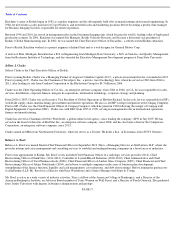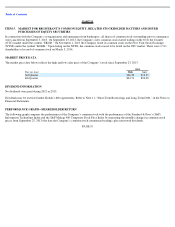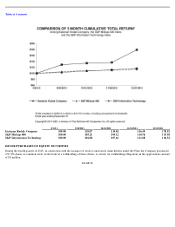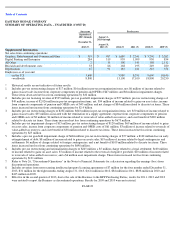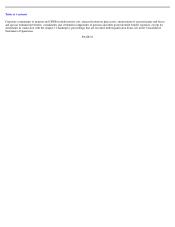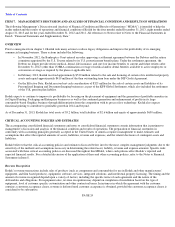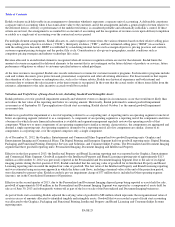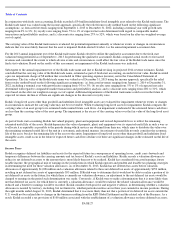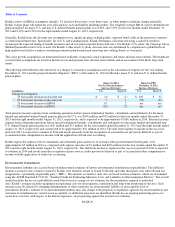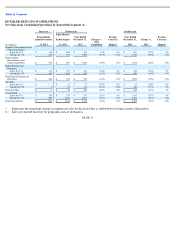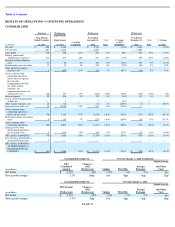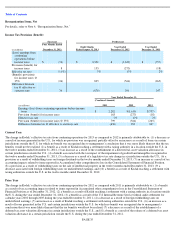Kodak 2013 Annual Report Download - page 29
Download and view the complete annual report
Please find page 29 of the 2013 Kodak annual report below. You can navigate through the pages in the report by either clicking on the pages listed below, or by using the keyword search tool below to find specific information within the annual report.
Table of Contents
In conjunction with fresh start accounting, Kodak recorded a $54 million indefinite-lived intangible asset related to the Kodak trade name. The
Kodak trade name was valued using the income approach, specifically the relief from royalty method based on the following significant
assumptions: (a) forecasted revenues ranging from September 1, 2013 to December 31, 2022, including a terminal year with growth rates
ranging from 0% to 3%; (b) royalty rates ranging from .5% to 1% of expected net sales determined with regard to comparable market
transactions and profitability analysis; and (c) discount rates ranging from 27% to 32%, which were based on the after-tax weighted-average
cost of capital.
The carrying value of the Kodak trade name is evaluated for potential impairment annually or whenever events or changes in circumstances
indicate that it is more likely than not that the asset is impaired. Kodak elected October 1 as the annual impairment assessment date.
For the 2013 annual impairment test of the Kodak trade name, Kodak elected to utilize the qualitative assessment due to the fresh start
valuation being performed as of September 1, 2013. In performing the qualitative assessment, Kodak compared actual results to forecasted
revenues and considered the extent to which adverse events and circumstances could affect the fair value of the Kodak trade name since the
fresh start valuation. Based on the results of this assessment, no impairment of the Kodak trade name was indicated.
Subsequent to the annual impairment test of the Kodak trade name and due to Kodak revising its projected 2014 revenue estimates, Kodak
concluded that the carrying value of the Kodak trade name, estimated as part of fresh start accounting, exceeded its fair value. Kodak recorded
a pre-tax impairment charge of $8 million that is included in Other operating expense (income), net in the Consolidated Statement of
Operations. The fair value of the Kodak trade name was valued as of December 31, 2013 using the income approach, specifically the relief
from royalty method based on the following significant assumptions: (a) forecasted revenues ranging from January 1, 2014 to December 31,
2022, including a terminal year with growth rates ranging from -3% to 3%; (b) royalty rates ranging from .5% to 1% of expected net sales
determined with regard to comparable market transactions and profitability analysis; and (c) discount rates ranging from 26% to 31%, which
were based on the after-tax weighted-average cost of capital. Additional impairments of the Kodak trade name could occur in the future if
expected revenues decline or if there are significant changes in the discount or royalty rates.
Kodak’s long-lived assets other than goodwill and indefinite-lived intangible assets are evaluated for impairment whenever events or changes
in circumstances indicate the carrying value may not be recoverable. When evaluating long-lived assets for impairment, Kodak compares the
carrying value of an asset group to its estimated undiscounted future cash flows. An impairment is indicated if the estimated future cash flows
are less than the carrying value of the asset group. The impairment is the excess of the carrying value over the fair value of the long-lived asset
group.
As part of fresh start accounting, Kodak fair valued property, plant and equipment and revised depreciable lives to reflect the remaining
estimated useful life of the assets. Kodak depreciates the value of property, plant, and equipment over its expected useful life in such a way as
to allocate it as equitably as possible to the periods during which services are obtained from their use, which aims to distribute the value over
the remaining estimated useful life of the unit in a systematic and rational manner. An estimate of useful life not only considers the economic
life of the asset, but also the remaining life of the asset to the entity. Impairment of long-lived assets other than goodwill and indefinite lived
intangible assets could occur in the future if expected future cash flows decline or if there are significant changes in the estimated useful life of
the assets.
Income Taxes
Kodak recognizes deferred tax liabilities and assets for the expected future tax consequences of operating losses, credit carry-forwards and
temporary differences between the carrying amounts and tax basis of Kodak’s assets and liabilities. Kodak records a valuation allowance to
reduce its net deferred tax assets to the amount that is more likely than not to be realized. Kodak has considered forecasted earnings, future
taxable income, the geographical mix of earnings in the jurisdictions in which Kodak operates and prudent and feasible tax planning strategies
in determining the need for these valuation allowances. As of December 31, 2013, Kodak has net deferred tax assets before valuation
allowances of approximately $1,008 million and a valuation allowance related to those net deferred tax assets of approximately $953 million,
resulting in net deferred tax assets of approximately $55 million. If Kodak were to determine that it would not be able to realize a portion of its
net deferred tax assets in the future, for which there is currently no valuation allowance, an adjustment to the net deferred tax assets would be
charged to earnings in the period such determination was made. Conversely, if Kodak were to make a determination that it is more likely than
not that deferred tax assets, for which there is currently a valuation allowance, would be realized, the related valuation allowance would be
reduced and a benefit to earnings would be recorded. Kodak considers both positive and negative evidence, in determining whether a valuation
allowance is needed by territory, including, but not limited to, whether particular entities are in three year cumulative income positions. During
the eight months ended August 31, 2013, Kodak determined that it was more likely than not that a portion of its deferred tax assets outside the
U.S. would not be realized due to changes in the business resulting from the KPP Global Settlement and the related sale of the Business. As a
result, Kodak recorded a tax provision of $100 million associated with the establishment of a valuation allowance on those deferred tax assets.
PAGE 27


